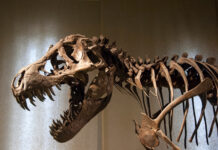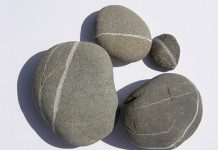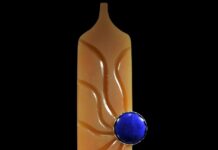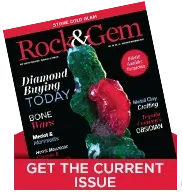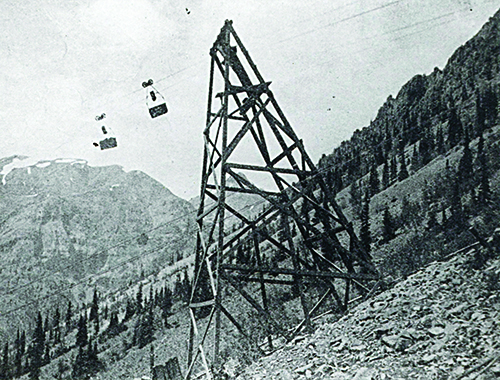
By Bob Jones
Of all the places a rockhound can vacation in summer, the most scenic, exciting, historical and enjoyable area is the San Juan Mountains, Southwest Colorado. Some of the most beautiful scenery in America is present in this area. Nothing compares with the Red Mountains, which are spectacularly stained bright red and orange because of massive mineralization.
Old gold and silver mines are found everywhere, some of them historically famous for their mineral specimens. These old silver and gold mines have produced fine collector specimens like rhodochrosite, huebnerite, sphalerite calcite, quartz, and fluorite, among others.
For family enjoyment, there is the spectacular 45-mile narrow gauge railroad that follows the Animas River from Durango to Silverton through Cascade Canyon. This railroad was built before 1900 to service the gold and silver mines surrounding Silverton, now a quaint tourist town.
Aerial Tram Views
Once in Silverton, you can enjoy tourist and rock shops and visit the classic old Mayflower Gold Mill where millions in gold were once processed, and where my son Bill learned his gold assaying skills. One of the many exciting aspects of this location is the aerial tram lines that brought rich ore from the high mountain mines to the mill. During shift changes, miners avoided the arduous climb to work by taking the tram to and from the mine in the swinging ore buckets. Miners could also spend their nights in the big boarding house near the mine entrances clinging to the high mountainside.
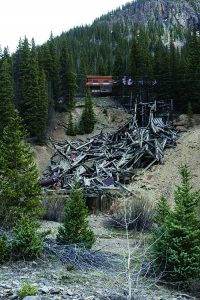
To see that old boarding house and enjoy the best underground mine tour in the state, drive from the Mayflower Mill to Cunningham Gulch to reach the Old Hundred Mine Tour.
If interested, look up the 1957 movie “Night Passage” featuring the Mayflower Mill, tram lines, and mines starring Jimmy Stewart and Audi Murphy. An exceptional time to visit Silverton is the second weekend in August when the community celebrates Hardrocker’s Holiday. Miners from the region compete in rock drilling, hauling, shoveling, and other physical contests all in good fun.
Silverton began as a gold camp, just one of three now-famous San Juan gold camps, including Telluride and Ouray. Connecting Silverton to Ouray is the Million Dollar Highway over Red Mountain Pass so named because the roadbed consists of discarded gold mine dump material. The path started as a toll road built by Otto Mears, who made his fortune building toll roads and railroads in San Juan. Connecting these old gold camps are rugged trails over the mountains that require using a four-wheel vehicle you can rent or hire with a guide.
Exploring Mayflower Mill History
With sharp switchbacks clinging to mountainsides, you can look straight down a thousand feet to see Telluride and the best of Colorado scenery. My favorite trail drive runs from Ouray past the famous Camp Bird gold mine toward Telluride. Just before topping out at the summit, you can turn off the trail to a parking area, park, and enjoy a picnic lunch while viewing the entire spectacular trio of Red Mountain Peaks.
If you wonder why I know so much about the San Juan area, it happens my son Bill worked as a gold assayer at the Mayflower Mill after college. Eventually, he bought the original Silverton Root Norton Assay Lab and did gold assaying for many of the area’s gold mines. During summers, my other son Evan joined Bill and worked in the lab as well.
My home base in the San Juan mountains has always been Silverton, which
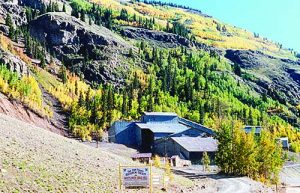
sits above 9,000 feet and is surrounded by mountains. It is delightful there in summer but tough in winter as snow accumulation can exceed fifteen feet.
The chief operating mine here was the American Tunnel at Gladstone near Silverton. One purpose for the Tunnel was to reach the old Sunnyside mine ore veins. When the Sunnyside mine ceased operations suddenly one day, Bill moved his assay lab but had already developed the Old Hundred Mine tour just outside Silverton. The Sunnyside mine, particularly during the digging of the American Tunnel, became very well known among rockhounds. To reach the Sunnyside and reopen it, miners had dug the American Tunnel through the Gold King mine properties. The Tunnel cut across a series of quartz veins that were rich in fine specimens of minerals. Most notable were countless rhodochrosite crystals and crystal groups on snow-white quartz. Much of the quartz is druzy, which offset the pink to red rhodochrosite crystals beautifully.
Sights and Specimens In The San Juan Mountains
The dominant color of the rhodochrosite here is pale to intense pink. The crystals formed rhombs ranging in size from less than an inch to nearly two inches on edge. Many crystals were twinned, and lovely flower-like rosettes of the pink mineral were typical. Specimens included free-standing single crystals and clusters stacked and completely covering a matrix. It is impossible to estimate the considerable quantity of examples that were brought to grass by miners.
The American Tunnel rhodochrosite did not occur with any amount of gold. This fact was brought to my attention when a Scottsdale collector called and said he had just returned from Silverton with a beautiful specimen of rhodochrosite and gold from the American Tunnel. When I checked the specimen, I smelled a rat because the gold did not seem intimately attached to the quartz. None of the gold appeared to penetrate the quartz. So, Chuck Lewis of Arizona State University tested the gold, and it proved to be lovely yellow brass. Luckily the Scottsdale fellow returned to Silverton and was able to get his money back.
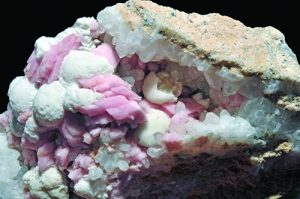
Mine in San Juan, Colorado. PARENT GÉRY, WIKIMEDIA COMMONS
While in Silverton, you might inquire at local shops about places to collect. Someone claims almost all land in the area, so collecting is varied. High on the mountain slopes as you drive up and park, you can walk the hills and find loose quartz crystals in places. Also, dumps are always worth checking. One area well worth a visit is the old gold camp, Eureka, located north of Silverton. It serviced the Sunnyside mine when it existed, and also the American Tunnel operation.
Along the roadsides of Silverton, you might find huge boulders rich in a pink mineral initially reported to be rhodonite. The gray to pink rock is tough but can be cut and polished nicely. Just keep in mind that while it may look like rhodonite, it is not. The gray to pink rock is the mineral pyroxmangnite.
As low-key as the community of Silverton is, on one particular day, June 4, 1978, it was anything but low key. My son Bill certainly remembers it because, at the time, he was handling the assay work on Standard Metals Sunnyside ore. That’s the day Mother Nature decided to close the mine, not with an earthquake but a flood. Mind you; the flood did not merely sweep through the tunnel, it tore through. Let me set the stage of what the scene was like as the flood of ‘78 moved through.
The Day Lake Emma Dropped
By the 1970s, the Sunnyside and other mines in the group had been operating for nearly a century. In the 1970s, Standard Metals opened the American Tunnel to reach a very rich gold vein. While most mining companies are happy with a rock that produces even a small percentage of gold, the Sunnyside vein offered more than a small portion of gold. As such, Standard Metals followed the rich vein as it trended vertically, up inside the mountain, toward a high mountain valley surrounded by peaks. Sitting in that broad valley, near the top of the mountain — over 12,000 feet in height — was glacial Lake Emma, which is frozen much of the year because of the high elevation. The gold vein ran directly under Lake Emma, and as mining proceeded, the rich vein continued, and engineers checked to be sure there was plenty of hard rock between the working face and the lakebed. However, there was a problem. The miners did not know there was a hidden fault in the lake bedrock.
On that fateful day, June 4, 1978, when no one was working in the mine, the
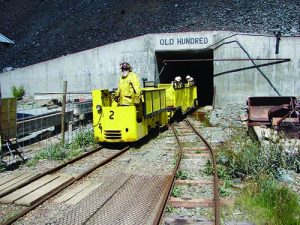
fault gave way, and the bottom fell out of Lake Emma. All of a sudden, lake waters had a wide-open pathway into and through the stopes, shafts, and tunnels as a result of obeying gravity to seek the lowest level, which was the American Tunnel.
Imagine the force a wall of water would have as it dropped a couple of thousand feet in vertical freefall. It ripped out timbers, track, track ties, steel ore cars, cars carrying dynamite. Everything in the path of the roaring waters was torn loose and crashed down through the shafts until it exited the mine tunnel. The debris and water flooded the nearby stream and caused extensive damage to the land downstream. Gold mining stopped, and any other minerals were long since flushed away.
It was just a few weeks later that I went to Silverton, and Bill and I drove up to what had been Lake Emma. Except for a few snowbanks nearby, what had been the lake was a deep funnel-shaped hole with exposed walls. Deep inside the tapered shaft, we could actually see the curving apex of the ore vein the crew had been working, which was the wall opposite our location. I could be wrong, but I thought I could see a broad streak of gold ore in that exposed vein.
Of course, this disaster ended any specimen production from the American Tunnel. However, even before the flood, production had already slowed to a crawl after the tunnel was complete. After the mining company cleaned up the area, the owners also attempted to reopen the operation, but the halcyon days of the American Tunnel and Sunnyside mine were over.
Characters of Silverton’s Rockhounding Community
Silverton has yet another rockhound claim to fame. Many old-timers, like myself, may remember Ed McDole. He was one of the hobby’s favorite characters. He worked as a contract miner in Butte, before becoming an itinerant mineral dealer, who traveled across the country in his black Lincoln
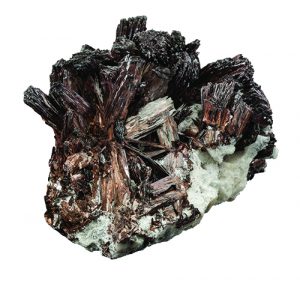
automobile, selling superb minerals. He was such a notable personality that a special trophy, bearing his name, used to be given to one deserving dealer during the Tuscon Gem and Mineral Show. The McDole trophy was for “The Best Damned Rock” in the show, which were Ed’s words and not mine. McDole died in Silverton after collecting huebnerite at the Adams mine, and during removal of items from his home, several flats filled with huebernite were found by his bed.
We will continue with an exploration of huebernite crystals found in the Adams mine, in Part Two of this series. In addition, I’ll discuss the legendary Camp Bird Mine near Quray, the Hope diamond, and the Otto Mears railroads and silver passes that quite literally opened the remote San Juan Mountains to the nation.



